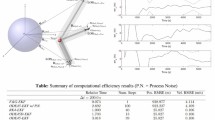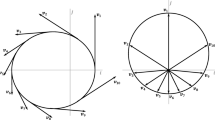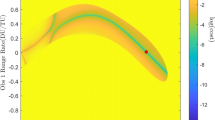Abstract
This paper presents an approach to characterize the uncertainty associated with the state vector obtained from the Herrick-Gibbs orbit determination approach using transformation of variables. The approach is applied to estimate the state vector and its probability density function for objects in low Earth orbit using sparse observations. The state vector and associated uncertainty estimates are computed in Cartesian coordinates and Keplerian elements. The approach is then extended to accommodate the \(J_2\) perturbation where the state vector is written in terms of mean orbital elements. The results obtained from the analytical approach presented in this paper are validated using Monte Carlo simulations and compared with the often utilized similarity transformation for Kepler, mean, and nonsingular elements. The measurement uncertainty characterization obtained is used to initialize conventional nonlinear filters as well as operate a Bayesian approach for orbit determination and object tracking.





















Similar content being viewed by others
References
Armellin, R., Di Lizia, P., Lavagna, M.: High-order expansion of the solution of preliminary orbit determination problem. Celest. Mech. Dyn. Astron. 112, 331–352 (2012)
Au, C., Tam, J.: Transforming variables using the Dirac generalized function. Am. Stat. 53(3), 270–272 (1999)
Battin, R.H.: An Introduction to the Mathematics and Methods of Astrodynamics (revised edn). AIAA, Reston, pp. 110–114, 125–130, 135, 109–212, 490–493, 743–744 (1999)
Broucke, R.: On the matrizant of the two-body problem. Astron. Astrophys. 6, 173–182 (1970)
Bryson, A.E., Ho, Y.C.: Applied Optimal Control: Optimization, Estimation, and Control. Blaisdell, Waltham, MA, pp. 299–301, 377–381, 385 (1969)
Crassidis, J.L., Junkins, J.L.: Optimal Estimation of Dynamic Systems. CRC Press, Boca Raton, FL, pp. 24–29, 81–84, 92–95, 123–128, 132–139, 149–154, 285–289, 310–314, 419–430, 450–463, 549, 553–567 (2004)
DeRusso, P.M., Roy, R.J., Close, C.M.: State Variables for Engineers. Wiley, New York, pp. 249–250, 254–262 (1965)
Escobal, P.R.: Methods of Orbit Determination. Wiley, New York, pp. 107–121, 228–231, 239, 293, 318 (1965)
Fujimoto, K., Scheeres, D.: Correlation and initial orbit determination for short-arc optical observation. In: Advanced Maui Optical and Space Surveillance Technologies Conference, Wailea, Maui, HI (2010a)
Fujimoto, K., Scheeres, D.: Correlation of optical observations of Earth-orbiting objects by means of probability distributions. In: AIAA/AAS Astrodynamics Specialist Conference, Toronto, Canada, AIAA-2010-7975 (2010b)
Fujimoto, K., Scheeres, D.: Correlation of multiple singular observations and initial state estimation by means of probability distributions of high codimension. In: American Control Conference, Toronto, Canada (2011)
Fujimoto, K., Scheeres, D., Alfriend, K.: Analytical nonlinear propagation of uncertainty in the two-body problem. J. Guid. Control Dyn. 35(2), 497–509 (2012)
Gim, D.W., Alfriend, K.T.: State transition matrix of relative motion for the perturbed noncircular reference orbit. J. Guid. Control Dyn. 26(6), 956–971 (2003)
Hari, B.S., Venugopalakrishna, Y.: On the use of dirac delta distribution in transformation of random variables. In: 14th National Conference on Communications, IIT Bombay, Mumbai, AIAA 2008-7211 (2008)
Hill, K., Alfriend, K.T., Sabol, C.: Covariance-based uncorrelated track association. In: AIAA/AAS Astrodynamics Specialist Conference and Exhibit, Honolulu, HI, AIAA 2008-7211 (2008)
Hough, M.: Improved performance of recursive tracking filters using batch initialization and process noise adaptation. J. Guid. Control. Dyn. 22(5), 675–681 (1999)
Jazwinski, A.H.: Stochastic Processes and Filtering Theory. Dover, Mineola, pp. 34–42, 55–56, 77–81, 85–92, 145–158, 174–175, 189–193 (1998)
Junkins, J.L., Singla, P.: How nonlinear is it? A tutorial of orbit and attitude dynamics. J. Astronaut. Sci. 52(1–2), 7–60 (2004)
Junkins, J.L., Akella, M.R., Alfriend, K.T.: Non-Gaussian error propagation in orbital mechanics. J. Astronaut. Sci. 44(4), 541–563 (1996)
Karimi, R.R., Mortari, D.: Initial orbit determination using multiple observations. Celes. Mech. Dyn. Astron. 109(2), 167–180 (2011)
Khuri, A.I.: Applications of dirac’s delta function in statistics. Int. J. Math. Educ. Sci. Technol. 35(2), 185–195 (2004)
Lee, D.J., Alfriend, K.: Sigma point filtering for sequential orbit estimation and prediction. J. Spacecr. Rocket. 44(2), 388–398 (2007)
Long, A., Cappellari, Jr J., Velez, C., Fuchs, A.: Goddard Trajectory Determination System (GTdS) mathematical theory (revision 1). Technical report NASA-CR-183462, NASA Goddard Spaceflight Center, pp. 5.43–5.63, 8.13–8.16 (1989)
Majji, M., Junkins, J.L., Turner, J.D.: High order keplerian state transition tensors. In: AAS/AIAA F. Landis Markley Astronautics Symposium, Cambridge, MD, AAS 08-270 (2008a)
Majji, M., Junkins, J.L., Turner, J.D.: A high order method for estimation of dynamic systems. J. Astronaut. Sci. 56(3), 401–440 (2008b)
Majji, M., Weisman, R.M., Alfriend, K.T.: Solution of the Liouville equation for Keplerian motion: Application to uncertainty calculations. In: AAS/AIAA Spaceflight Mechanics Conference, Charleston, SC, AAS 12–262 (2012)
Mosegaard K, Tarantola A (2002) International Handbook of Earthquake and Engineering Seismology: Part A, International Geophysics Series, vol 81A, Academic Press, New York, NY, Chap. 16 : Probabilistic Approach to Inverse Problems. pp. 237–265 and Appendices A-P.
Muinonen, K., Bowell, E.: Asteriod orbit determination using Bayesian probabilities. Icarus 103(2), 255–279 (1993)
Papoulis, A.: Probability, Random Variables, and Stochastic Processes, 3rd edn. McGraw-Hill, Boston, MA, pp. 135–148, 151–154, 164–166, 169–170, 192–195, 297–303, 635–654 (1991)
Park, R.S., Scheeres, D.J.: Nonlinear mapping of Gaussian statistics: theory and applications to spacecraft trajectory design. J. Guid. Control Dyn. 29(6), 1367–1375 (2006)
Ristic, B., Arulampalam, S., Gordon, N.: Beyond the Kalman Filter: Particle Filters for Tracking Applications. Artech House, Norwood, MA, pp. 4–9, 19–32, 35–57 (2004)
Sabol, C., Sukut, T., Hill, K., Alfriend, K.T., Wright, B., Li, Y., Schumacher, P.: Linearized orbit covariance generation and propagation analysis via simple Monte Carlo simulations. In: AAS/AIAA Spaceflight Mechanics Meeting, San Diego, CA, AAS 10-134 (2010)
Schaub, H., Junkins, J.L.: Analytical Mechanics of Space Systems, 1st edn. AIAA, Reston, VA, pp. 72–82, 87–91, 95–101, 133–135, 404–418, 479–483, 519–525, 693–696 (2003)
Scheeres, D.J., Hsiao, F.Y., Park, R., Villac, B., Maruskin, J.: Fundamental limits on spacecraft orbit uncertainty and distribution propagation. J. Astronaut. Sci. 54(3–4), 505–523 (2005)
Schneider, M.: Bayesian linking of geosynchronous orbital debris tracks as seen by the large synoptic survey telescope. Adv. Space Res. 49(4), 655–666 (2011)
Shamilov, A., Yuzer, A.F., Agaoglu, E., Mert, Y.: A method of obtaining distributions of transformed random variables by using the heaviside step function and dirac generalized functions. J. Stat. Res. 40(1), 23–34 (2006)
Stark H, Woods JW (2002) Probability and Random Processes with Applications to Signal Processing, 3rd edn. Prentice-Hall, Upper Saddle River, pp. 158–159, 174–175
Stewart, J.: Calculus: Early Transcendentals, 4th edn. Brooks/Cole, Pacific Grove, CA, pp. 1020–1022, 1026–1033 (1999)
Tapley, B.D., Schutz, B.E., Born, G.H.: Statistical Orbit Determination. Elsevier, Burlington, MA, pp. 230–233, 244–245, 251–258, 493–497 (2004)
Turner, J.D., Majji, M., Junkins, J.L.: High-order state and parameter transition tensor calculations. In: AIAA/AAS Astrodynamics Specialist Conference, Honolulu, HI, AIAA-2008-6453 (2009)
Vallado, D.A.: Covariance transformations for satellite flight dynamics operations. In: AAS/AIAA Astrodynamics Specialist Conference, Big Sky, MT, AAS 03-526 (2003)
Vallado, D.A.: Fundamentals of Astrodynamics and Applications, 3rd edn. Microcosm, Hawthorne, CA, pp. 103–119, 153–167, 708–711, 721–722, 783–792, 806–811, 817–823 (2007)
Virtanen, J., Muinonen, K.: Time evolution of orbital uncertainties for the impactor candidate 2004 \(\text{ AS }_1\). Icarus 184(2), 289–301 (2006)
Virtanen, J., Muinonen, K., Bowell, E.: Statistical ranging of asteroids. Icarus 154(2), 412–431 (2001)
Weisman, R.M.: Nonlinear transformations and filtering theory for space operations. Ph.D. thesis, Texas A &M University, College Station, TX (2012)
Weisman, R.M., Majji, M., Alfriend, K.T.: Analytic assessment of sensor uncertainty for application to space object tracking and correlation. In: 62nd International Astronautical Congress: Space Debris Symposium, Cape Town, South, Africa, IAC-11-A6.6.7-10729 (2011a)
Weisman, R.M., Majji, M., Alfriend, K.T.: Application of the transformation of variables technique for uncertainty mapping in nonlinear filtering. In: AAS/AIAA Astrodynamics Specialist Conference, Girdwood, AK, AAS 11-604 (2011b)
Weisman, R.M., Majji, M., Alfriend, K.T.: Analytic characterization of measurement uncertainty and initial orbit determination on orbital element uncertainty and correlation. In: AAS/AIAA Spaceflight Mechanics Conference, Kauai, HI, AAS 13-203 (2013)
Weisman, R.M., Majji, M., Alfriend, K.T.: Application of the transformation of variables technique for uncertainty mapping in nonlinear filtering. Celest. Mech. Dyn. Astron. (2014). doi:10.1007/s10569-013-9527-2
Author information
Authors and Affiliations
Corresponding author
Additional information
Presented in part as Paper AAS 13-203 at the AAS/AIAA Spaceflight Mechanics Conference, Kauai, HI., Feb. 10–14, 2013.
Electronic supplementary material
Below is the link to the electronic supplementary material.
Appendix 1
Appendix 1
This appendix demonstrates the TOV technique for instances where the desired domain has the same number of base functions as the initial domain and when the desired domain has less base functions than the initial domain.
1.1 Transformation of variables for \(\mathfrak {R}^n\rightarrow \mathfrak {R}^m \, , \, m = n\)
Consider the two-dimensional mapping of Cartesian coordinates, \(\mathbf{x} \doteq \left( x, y\right) \), from a range and angle pair set, \(\mathbf{z}\doteq \left( \rho ,\alpha \right) \), Eq. (26). Let the spherical domain be the initial domain with a given continuous joint PDF, \(p\left( \mathbf{z}\right) \), the Cartesian domain PDF, \(p\left( \mathbf{x}\right) \), is computed by applying Eq. (1) and the result shown in Eq. (27).
1.2 Transformation of variables for \(\mathfrak {R}^n\rightarrow \mathfrak {R}^m\, ,\, m < n\) (auxiliary variable method)
When concerned with a subset of variables related to the initial domain, the method of auxiliary variables (Papoulis 1991) can be applied to populate a square Jacobian. Let the auxiliary variable be the angle, \(\alpha \), this results in a square Jacobian, Eq. (28), and joint and marginal PDFs shown by Eq. (29). With \(\rho \) as the auxiliary variable, Eq. (30) would result. Equations (29) and (30) are derived differently based upon elimination of auxiliary variables but are equivalent due to the invariance of total probability.
1.3 Transformation of variables for \(\mathfrak {R}^n\rightarrow \mathfrak {R}^m\, ,\, m < n\) (Dirac delta method)
The reduced state variable PDF representation for continuous or discrete random variables can be computed using the Dirac delta method (Au and Tam 1999). The method applies the Dirac generalized function in order to transform only the needed variables to the state(s) of interest, the continuous random variables the application is given by Theorem 1.
Theorem 1
Suppose that \(z_i,\,i=\left[ 1,n\right] \), are continuous random variables with joint probability distribution \(p\left( z_1,\ z_2, \dots , \ z_n\right) \). Let \({\fancyscript{D}}\) be the \(n\)-dimensional set of every possible outcome of the \(z_i\)’s. Then the continuous random variable
has the probability distribution given by use of the Kronecker delta \(\delta _{a,b}\) in the form
To compute the result of Theorem 1, properties of the Kronecker delta are required and given by Eq. (32). The composition property in Eq. (32) is computed using the roots, \(y_n\), of the function \(f\), hence \(f(y_n)=0\). For the translation property the limits of integration can be over any domain surrounding the critical points where the Kronecker delta is not zero. The Kronecker delta scaling, sifting, and translation properties allow for the theorem to be carried out.
Application of Theorem 1 allows for Eq. (29) to be computed without the need for evaluating the \(2\times 2\) Jacobian, shown in Eq. (33). The roots of \(x-\rho \cos (\alpha )=0\) are \(\rho =x/\cos (\alpha )\) and \(\alpha = \arccos (x/\rho )\), using the first root to replace the range random variable results in the scaling factor to be \(\frac{\partial }{\partial x}\left( x/\cos (\alpha )\right) = \sec (\alpha )\). Once the distribution is properly scaled, it can then be sifted to alleviate dependence on the range random variable, leaving only the angle random variable to be integrated over to produce the desired marginal PDF.
Equation (30) can be reproduced in a similar manner by utilizing the angle root, \(\alpha = \arccos (x/\rho )\), and using its derivative with respect to the state of interest, \(x\), for the scaling factor as shown by Eq. (34). Further examples of the application of the method can be found in (Khuri 2004; Shamilov et al. 2006; Hari and Venugopalakrishna 2008).
Rights and permissions
About this article
Cite this article
Weisman, R.M., Majji, M. & Alfriend, K.T. Analytic characterization of measurement uncertainty and initial orbit determination on orbital element representations. Celest Mech Dyn Astr 118, 165–195 (2014). https://doi.org/10.1007/s10569-013-9529-0
Received:
Revised:
Accepted:
Published:
Issue Date:
DOI: https://doi.org/10.1007/s10569-013-9529-0




